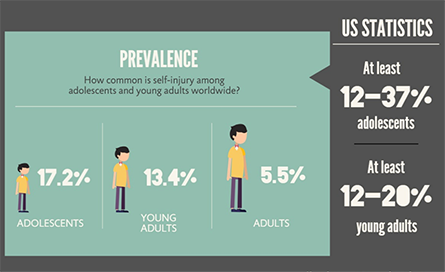FACTS AND FIGURES
Learn about statistics, trends, and other relevant insights for behavioral health practitioners working to improve health outcomes.
Non-suicidal Self Injury (NSSI)
Non-suicidal self-injury (NSSI), or self-harm, involves deliberate behaviors to cope with emotional distress and is a growing concern
among adolescents and young adults. According to the Cornell Research Program on Self-Injury and Recovery, 17.2% of adolescents and
13.4% of young adults engage in self-injury globally, whereas in the US, rates of prevalence range from 12% to 37% among adolescents
and 12% to 20% among young adults
1. This research emphasizes the urgent need for awareness and intervention. While self-harm is not
always linked to suicidal intent, it increases the risk of future suicidal behaviors and often coexists with depression, anxiety, and
other mental health conditions.

Source:
Self-injury
March is Self-Harm Awareness Month, which raises awareness and advocates for early intervention for those struggling with
NSSI. Self-harm is often misunderstood, leading many to suffer in silence out of fear of judgment. Creating open, compassionate
conversations and ensuring access to supportive resources are essential to addressing the issue.
SAMHSA’s initiatives, like the 988
Suicide & Crisis Lifeline
and
the
Suicide Prevention Resource Center
, highlight the need for early intervention and compassionate support. Reduced stigma,
fostering trauma-informed care, and expanding mental health resources can help ensure young people receive the support they need to heal.
*If you or someone you know is struggling with self-harm, reach out to
Suicide Prevention Resource Center988

for free, confidential support.*
Please see SAMHSA’s and other resources for addressing self-harm: